What is Farcaster? Exclusive Review of the Next-Gen Social Network
Web3 has seen a wave of new social applications like Friend.tech, Fantasy top, and Farcaster. While most are consumer-facing applications, Farcaster has built a strong infrastructure layer that paves the way for a decentralized social graph, tracking users and their overall social data.
What is Farcaster?
Farcaster is a decentralized social platform that combines on-chain identity creation, storage leasing, and key maintenance with off-chain data storage maintained by a decentralized network of nodes. This structure allows users to own their data and identity, forming a decentralized social graph.
Overview of Farcaster
- Channels and Frames are key elements for user engagement. Channels facilitate centralized community discussions by embedding URLs, while Frames turn broadcasts into interactive applications, supporting activities like NFT minting, voting, and secure transactions. These features promote diverse and personalized content delivery, enhancing the user experience.
- Farcaster’s open social graph and content algorithms offer unique opportunities for developing diverse clients, including those focused on AI, video, and audio applications. This openness reduces platform risk, allows innovation, and holds the potential to create “magic moments” that can lead to the success of social applications.
- Farcaster’s ID registry can serve as a foundational identity layer in Web3, addressing authentication and accountability issues. It provides secure, verifiable identities linked to various Web3 services, enhancing trust and transparency while managing ownership and responsibility in a decentralized environment.
- Key challenges include the potential issues of importing 1:1 social graphs from existing platforms, resilience during bear markets, managing bots and automated accounts, and achieving mainstream adoption beyond the crypto community. Addressing these challenges is crucial for Farcaster’s long-term success.
- Farcaster’s decentralized and open infrastructure paves the way for innovative applications and user-controlled social media landscapes. By focusing on strategic planning, community engagement, and user-centric features, Farcaster can overcome its challenges and lead the next wave of social media, offering a more secure, dynamic, and user-driven platform.
Farcaster Hub
From a high-level perspective, Farcaster executes high-priority operations on-chain, such as ID creation, storage leasing, and key maintenance for different applications. However, storage itself is an off-chain solution maintained by the decentralized network of nodes called the “Farcaster Hub.”
This infrastructure design contributes to Farcaster’s decentralized social graph, connecting users and their social activities. It could be the beginning of an identity layer that allows reliable authentication operations and transactions, reducing fraud risk and ensuring accountability—a significant obstacle to broader blockchain technology adoption.
Users can link their Farcaster identity to various Web3 services, enhancing trust and transparency across the decentralized network.
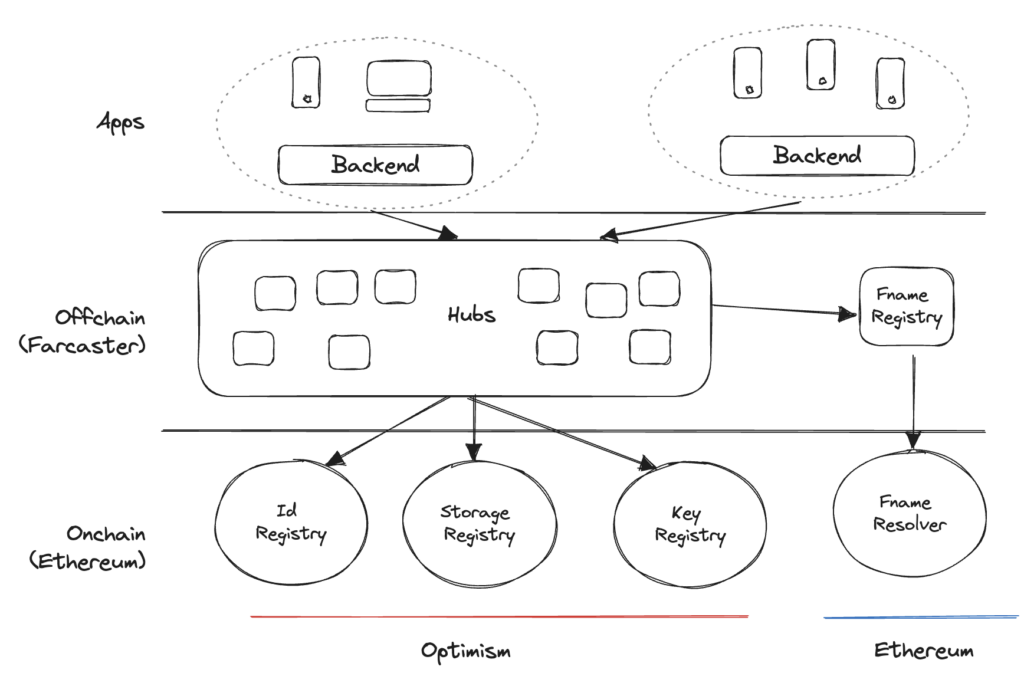
Additionally, by enabling recovery mechanisms and secure identity transfers, Farcaster provides a practical solution to one of blockchain technology’s most persistent issues: managing and proving ownership and accountability in a decentralized environment.
Key features like Channels and Frames enhance user engagement, while the robust ecosystem supports scalability and adoption.
Channel in Farcaster
Channel is public space for community discussion topics, prototyped in Warpcast. They are similar to hashtags on Twitter but provide a more personalized and independent space for communities, appearing as embedded URLs.

Channels follow the “Cozy Corner” theory in Farcaster, allowing small communities to emerge within the larger social graph. This is a significant differentiator, as Farcaster’s founders realized this vision could make the product stand out in building a stronger social graph.
Although this concept is a feature of Warpcast, the plan is to fully decentralize it because Dan Romero recognizes its unique value proposition. By fostering these small, concentrated communities, Channels can enhance user engagement and create more intimate social experiences.

In Farcaster, casts (similar to tweets) can link to any URL, not just other broadcast casts. This allows for new dynamics based on the same URL. For example, all broadcasts in the Degen channel link to the URL corresponding to the Degen token contract.
Leveraging this feature, Farcaster can develop diverse content dynamics. The ability to embed URLs in casts enables the creation of dynamics that include various content types. This drives the vision of Farcaster users owning their data, while traditional social media platforms use user data to personalize feeds and content through algorithms.
Frames in Farcaster
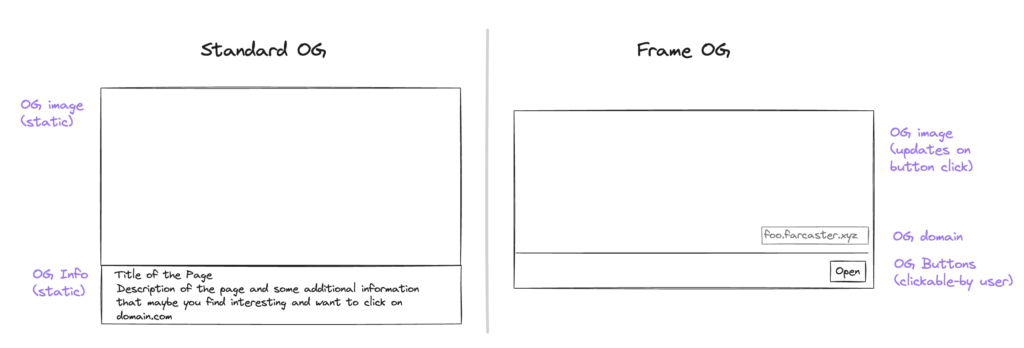
Frames turn any broadcast into an interactive application, creating interactive and authenticated experiences on Farcaster by setting standards. Essentially, it is a broadcast with images and buttons, allowing interaction with different servers, making it an app within an app.
Use cases include claiming or minting NFTs, voting, and facilitating token airdrops. In its first week, over 400 applications published nearly 1,000 Frames, directly contributing to Farcaster’s growth and providing incentives like airdrops to active users.
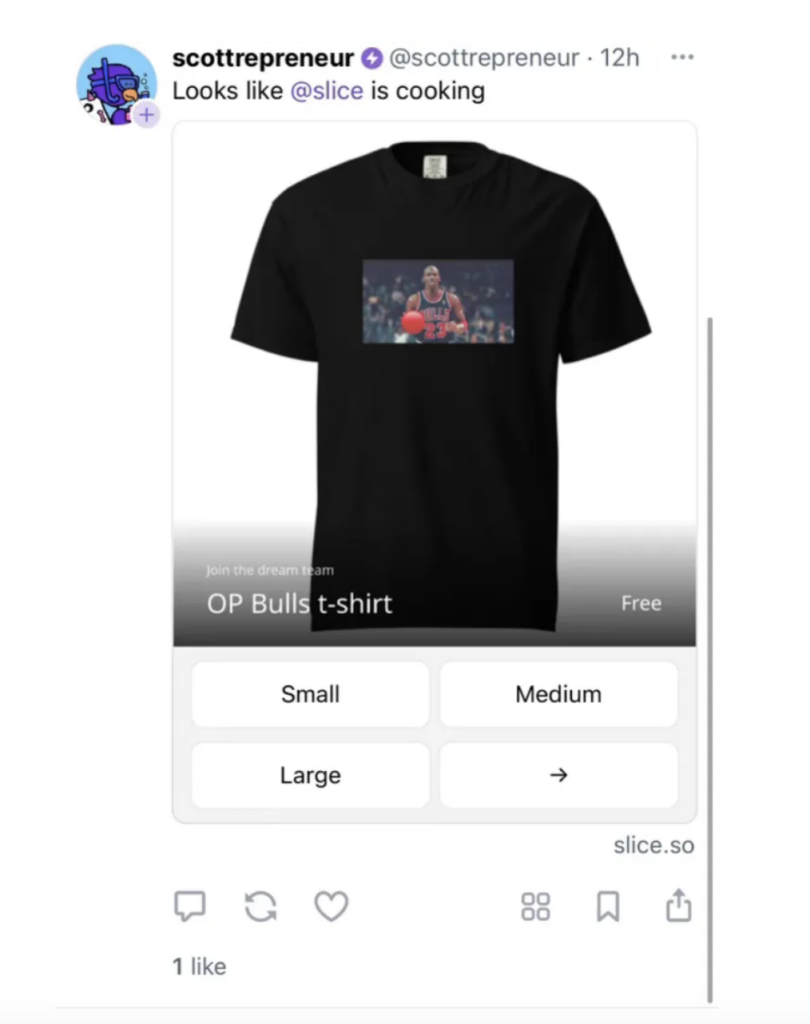
The theory behind Frames is that most social applications are 80-85% similar, but the remaining 15-20% of unique value enables different applications to dominate different markets. The Frame system allows Farcaster to integrate with more on-chain activities, forming a positive feedback loop that could increase Farcaster’s user base.
Simultaneously, it positions Farcaster as a more intuitive product, expanding social media’s functionality and offering a richer consumer experience (e.g., a more integrated Facebook Marketplace or TikTok Shop).
The most powerful feature of Frames is the seamless integration of Farcaster’s authenticated data with Frame servers. When users interact with a frame, the client transmits authenticated data from Farcaster to the Frame server. This process provides the server with verified proof of user interaction with the frame and confirms that the user owns the wallet associated with their Farcaster account.
Since Farcaster and wallet data are both public and transparent, Frame servers can leverage this information to create rich, verified, and customized interactions. This opens up many possibilities, such as personalized content delivery, secure transactions, and tailored user experiences.
For example, servers can authenticate user participation in voting, ensure the legitimacy of NFT claims, or facilitate secure token airdrops. This integration of authentication and wallet verification significantly enhances user experience by enabling trusted and interactive applications within the Farcaster ecosystem.
Clients of Farcaster
In the early Web2 days, platforms like Twitter saw various third-party clients providing diverse user experiences. However, as these platforms grew, they often restricted API access to protect their own clients and prepare for IPOs. Building alternative clients for major Web2 platforms became unpopular due to the high platform risk involved.
For Farcaster, this presents a unique and underexplored opportunity in the form of clients, which are essentially some applications that host infrastructure to display the social graph more digestibly and interactively.
In the Web3 paradigm, the most valuable assets of a social platform—its social graph and content algorithms—are open to all. This openness significantly reduces platform risk and could signal a paradigm shift.
Currently, the most used Farcaster client is Warpcast, developed by the Farcaster team. However, this is just the beginning. The platform has yet to experience the “magic moments” that many successful social applications have demonstrated.
Magic moments are unique combinations of user experience and behavior that make an application stand out, such as seeing what friends are doing on Facebook for the first time, finding matches on Tinder, watching TikTok videos, or making one-click purchases on Amazon.
Potential for Diverse Farcaster Clients
- AI-Focused Client: An AI-driven Farcaster client could summarize social media activities, similar to ChatGPT, rather than having users scroll through long feeds. High-quality Farcaster channels could provide valuable data sources for AI training. Channel owners should be compensated when their data is used for model training.
- Video-Focused Client: Given the success of video-centric applications in Web2, a video-focused Farcaster client is a promising idea. This client could leverage Farcaster’s decentralized nature to offer unique video content and interactions.
- Audio-Focused Client: Although no major social audio applications have emerged yet, an audio-focused Farcaster client has potential. This could explore new ways of social interaction through audio content, building on the success of applications like Clubhouse.
By exploring these diverse client possibilities, Farcaster can create a vibrant ecosystem where different applications cater to various user needs and preferences. This not only drives user growth and engagement but also fosters innovation within the Farcaster community.
Current State of Farcaster
To provide a fundamental overview of Farcaster’s current ecosystem, we can focus on the following aspects of its ecological dynamics.
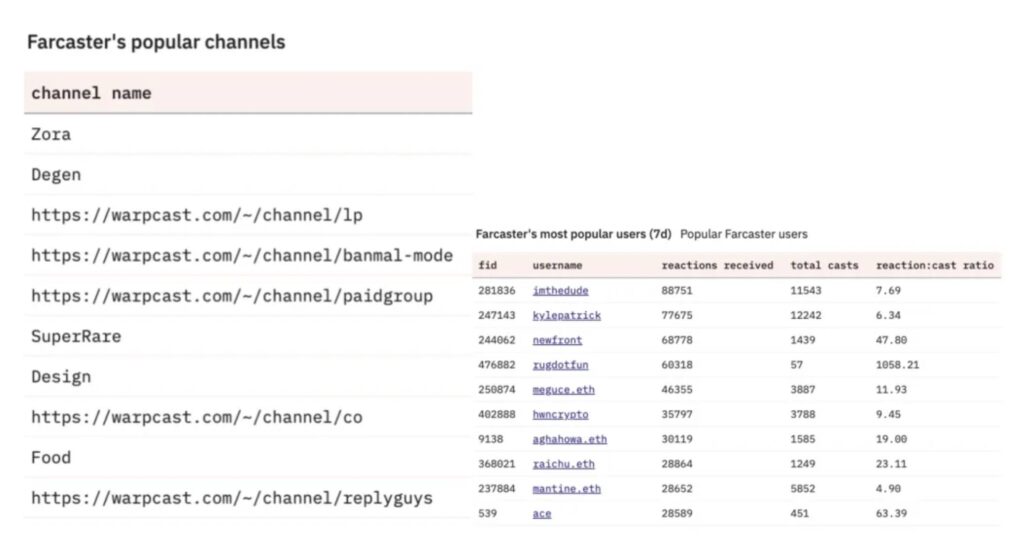
Notably, Warpcast currently accounts for 90% of network activity, but other clients can offer various unique proposals based on this infrastructure. Most people use it purely as a Web2 social media platform because users have not yet been trained to utilize all it offers.
Significant growth signals will come from individuals using Farcaster’s native solutions, making the user experience closest to the expected various features (decentralized social graph, Frames, etc.). This may take time as the graph itself is still in its early stages and not mature or robust enough.
Data Performance

According to Dan Romero, there is still work to be done in terms of scaling. Farcaster’s current architecture can scale to 10 million active users. However, from a technical perspective, the infrastructure is flexible enough, and the team is confident about further scaling when necessary.
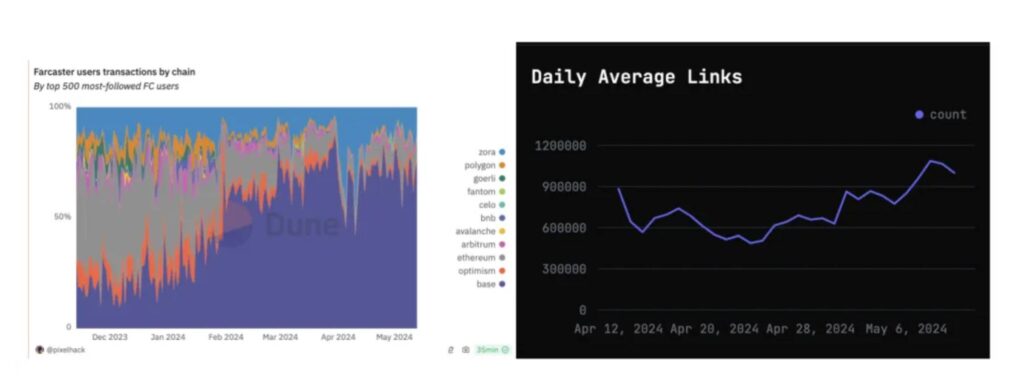
We see increased foundational adoption, such as the $DEGEN token guiding the network through incentive rewards and community engagement. This can be seen as a vertical domain, with Farcaster playing a secondary role. As more consumer-focused platforms like Base offer seamless user experiences, the adoption of protocols like Farcaster may see related increases.
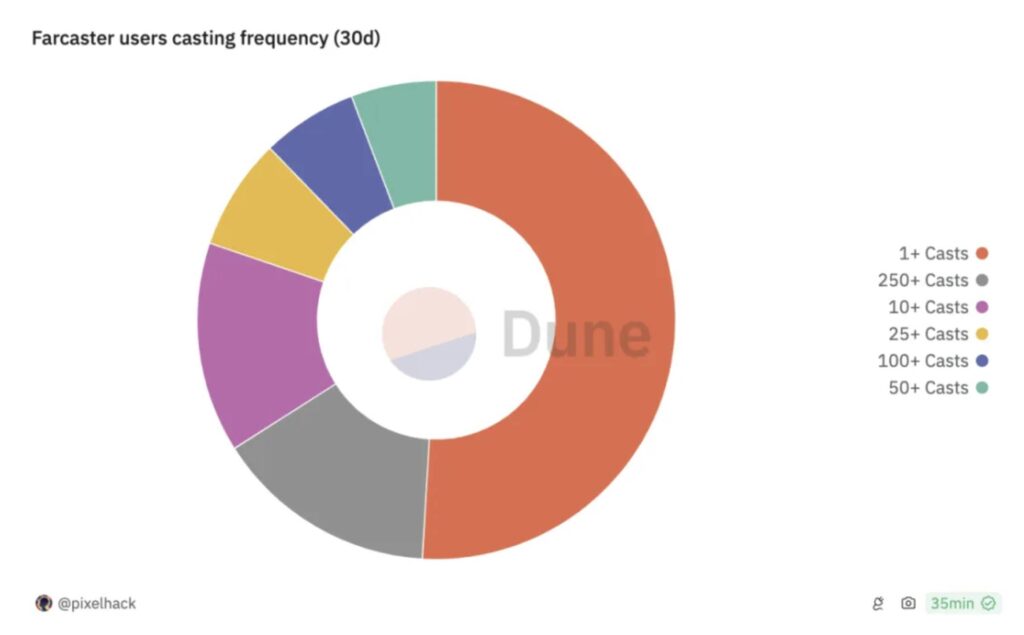
Within Farcaster and the social applications’ scope, this is a fascinating data point. About half of the users use it once a month, but the high retention rate of the other half, a highly active user community (second highest is over 250 casts), indicates that it adds high value to niche communities.
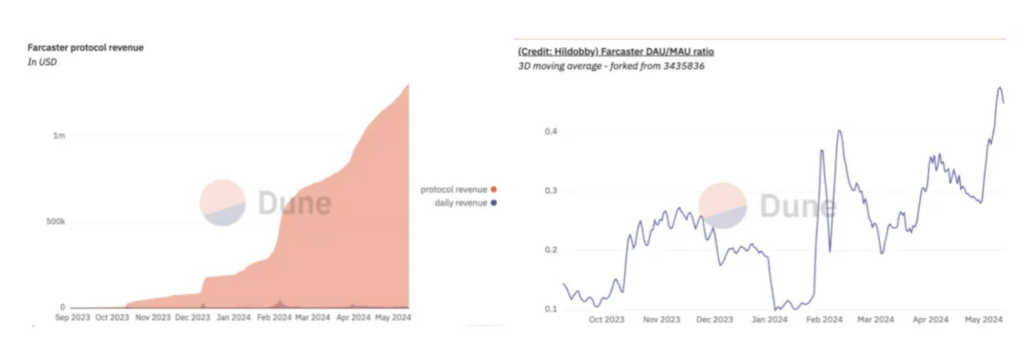
A higher DAU/MAU ratio also suggests increasing retention rates for Farcaster, with daily user numbers approaching monthly user numbers. This significantly and almost directly contributes to revenue growth for the Farcaster team.

Within a few months, a large number of people paid for services such as storage leases. This is partly due to the growing number of users building applications on Farcaster. Maintaining a Farcaster account requires $3 annually, a spam and bot prevention measure.
It will be fascinating to see how many people retain and value the product’s quality enough to pay for it, compared to free platforms like Twitter or Instagram, over the next year.
Three Waves of Applications Theory
As we navigate the evolving landscape of social media, now is a good time to deconstruct the monolithic stack of established platforms like Meta, X (formerly Twitter), Telegram, and Medium. Farcaster offers a unique opportunity to rebuild these layers on a decentralized, open network.
Entrepreneurs and startups can capitalize on this opportunity to own and co-own every layer of this emerging ecosystem, innovating and creating on Farcaster’s open canvas.
First Wave: Building the Infrastructure
The first wave focuses on establishing robust infrastructure. This foundational stage is crucial for enabling developers to build applications on Farcaster quickly and efficiently.
- Tools: Tools are needed to simplify the application-building process. Who will create Farcaster’s “Heroku,” providing developers with resources and support to seamlessly launch applications?
- API: The effectiveness of the official Farcaster API is another critical component. Is it user-friendly and powerful enough to support diverse applications? If not, who will develop Farcaster’s “Twilio,” simplifying API integration and extending functionality?
- Data: Just as Etherscan has become essential for navigating Ethereum, Farcaster needs robust data tools as it evolves. These tools will reorganize and make Farcaster data more accessible, supporting various use cases as the ecosystem matures.
Second Wave: Driving Network Growth Through Applications
Simultaneously, the second wave involves driving network growth through innovative applications. This growth can be divided into user growth and revenue growth, both crucial for Farcaster’s expansion.
- User Growth: Viral applications or compelling Farcaster client applications can significantly increase user numbers. By creating engaging user experiences, these applications will attract more people to join the Farcaster network and cultivate vibrant communities.
- Revenue Growth: Applications leveraging the financialization and tokenization aspects of Web3 can enhance revenue streams. These applications will enable Farcaster users to generate income, providing monetary incentives for interacting with the platform. Increased revenue for the Farcaster protocol can fund more paid user acquisition, creating a positive growth and investment feedback loop.
Third Wave: Engagement Networks – Cautious Growth Guidance
While infrastructure and growth-oriented applications are essential, caution is needed when considering applications solely aimed at driving engagement. These applications typically rely heavily on the existing user base and may struggle to grow independently.
Investing in engagement-driven applications too early may lead to stagnant growth if they cannot sustain growth through user acquisition.
Second Theory: Learning from the Past
One valuable approach to leveraging Farcaster’s potential is to study the challenges faced by Web2 social applications due to restrictions or pressures from major platforms. Many of these applications were banned, acquired, or forced to pivot despite having innovative features and user engagement strategies that posed significant threats to large platforms.
In a more open Web3 environment, these ideas have the potential to thrive without the constraints of centralized control.
Examples from the Twitter Ecosystem:
- Meerkat: A live-streaming app that initially succeeded until Twitter restricted its access to the social graph, hindering its growth.
- Klout: Known for measuring social media influence, the app faced limitations due to changes in API access and eventually shut down.
- Favstar: Provided a popular service for tracking liked tweets and retweets until Twitter’s API changes rendered its functionality useless.
Examples from the Facebook/Meta Ecosystem:
- tbh: An anonymous social media app for teenagers, acquired and then shut down by Facebook.
- Poke: Facebook’s own app, similar to Snapchat, eventually discontinued.
Opportunities in the Web3 Paradigm
In the decentralized and open environment of Web3, similar ideas and innovations can find new life. Farcaster’s infrastructure allows for the creation and integration of diverse applications without worrying about restrictive API policies or centralized control.
This openness can spark a renaissance of innovative social applications, fostering a rich ecosystem where:
- User-Driven Innovation: Developers are free to experiment and build on Farcaster, creating unique applications that cater to niche audiences or novel use cases.
- Decentralized Ownership: Users enjoy more control and privacy by owning their data and interactions, increasingly important in the digital age.
- Resistance to Centralized Control: Without a central authority imposing restrictions, applications on Farcaster can evolve more naturally based on user needs and feedback.
This approach not only rekindles the innovative spirit of past social applications but also ensures a more resilient and user-centric social ecosystem. Entrepreneurs have the opportunity to revisit and reimagine these once-promising ideas, allowing for greater customization and user control.
Challenges Faced
Despite Farcaster’s promising potential, several challenges must be addressed to ensure its long-term success and adoption.
1. Reservations about Importing 1:1 Social Graphs
One challenge for Farcaster is the potential issues with importing 1:1 social graphs from existing platforms. While integrating existing social graphs can simplify the transition for new users, it may not foster the same community dynamics as those developed natively.
Imported social graphs may not translate well to Farcaster’s decentralized environment, leading to a disjointed user experience. The community is highly receptive to customized application experiences and social applications that provide status games for new influencers.
However, a strong graph of established key opinion leaders and significant figures might diminish this experience, which is what many users seek in social media. As demonstrated by products like Instagram Reels, TikTok, and YouTube Shorts, many influencers within the same platform can recycle their content across different platforms, potentially offering unique opportunities for these influencers to leverage Farcaster’s graph.
2. Decline of Social Products During Bear Markets
Historically, many Web3 social products struggle during bear markets. The downturn in the crypto market often leads to decreased user engagement and investment, severely impacting the growth and sustainability of platforms like Farcaster.
To build resilience against market fluctuations, Farcaster needs to ensure its value proposition extends beyond the crypto community, attracting a broader audience. Diversifying its user base and creating engaging, non-market-dependent features will be key to weathering market volatility.
3. Presence of Bots on Social Media Platforms
The presence of bots and automated accounts is a common issue on social media platforms, and Farcaster is no exception. Bots can distort user engagement metrics, spread misinformation, and create an environment unfriendly to genuine users—similar to Sybil attacks.
Implementing robust bot detection and prevention measures is crucial for maintaining the ecosystem’s integrity. Prioritizing user verification and developing algorithms/mechanisms to identify and mitigate bot activity (fortunately, several applications on Farcaster like Phaver or Desmos are attempting to address this issue) can create a safer and more authentic social space while preserving the unique identity layer envisioned in Farcaster’s design.
Future of Mass Adoption
Breaking out of the crypto community’s echo chamber and achieving mass adoption is one of Farcaster’s biggest challenges. While the platform has gained traction among crypto enthusiasts, attracting a broader public user base will require overcoming several hurdles, including education, ease of use, and perceived value.
Simplifying the onboarding process, providing user-friendly interfaces, and highlighting Farcaster’s unique advantages over traditional social media platforms will be key strategies. Additionally, promoting Farcaster’s decentralized, user-owned features can attract users concerned with privacy and data ownership.
All of this ties into Farcaster’s marketing strategy, educating a broader audience about the unique value Farcaster adds to niche communities beyond the crypto space.
Conclusion
Farcaster is essentially a social infrastructure layer that allows communities to audit users, and users can audit communities through its core functions: identity verification, graphs, dynamics, and frames. This is all made possible by the protocol’s unique design and the ability for developers and entrepreneurs to leverage the platform’s social graph creatively.
Farcaster’s greatest value proposition lies in its identity layer and the ability for users to own their data rather than large corporations—a point validated in the narrative of large social companies facing scrutiny for data misuse.
Despite challenges such as integrating social graphs, market volatility, bot management, and achieving mainstream adoption beyond the crypto space, these obstacles are not insurmountable. Through strategic planning and innovation, Farcaster can overcome these barriers and pave the way for a new era of decentralized social networks.
A robust infrastructure, combined with the openness and transparency of Web3, provides fertile ground for innovative applications and user experiences that are impossible in the Web2 paradigm. By leveraging the unique advantages of the Farcaster protocol, developers can create diverse and engaging applications that drive user growth and engagement, fostering a vibrant and resilient ecosystem.
Looking ahead, Farcaster’s commitment to decentralization, user autonomy, and innovative features positions it as a potential leader in the next wave of social media platforms. This journey will require continuous improvement, community involvement, and a constant focus on user needs. Building a safer, user-controlled, and dynamic social media landscape is a goal worth striving for.
Farcaster is not just building a platform; it is laying the foundation for a new way of social interaction in the digital age.